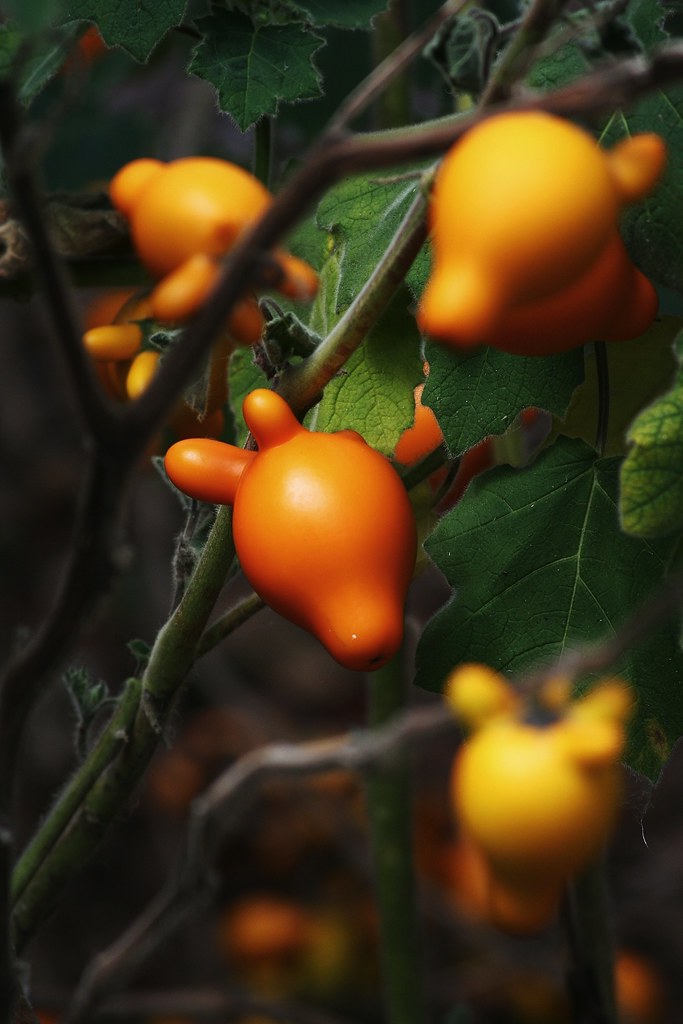The Titty Fruit – A Crop like No Udder
Posted by MydeaMedia
Sometimes you really do give the name of a plant a quick double take just to see if you had read it correctly. Solanum mammosum, to give the Latin name to this strange fruit, is one of those. It has a variety of names in the English language – but the best by a long chalk is the Titty Fruit. We will have a look at some of the alternatives (which are almost as Carry On in their capacity to raise a dirty snigger) a little later.
Image Credit Flickr User jam343
Bizarrely enough what you are looking at is a relative of the potato and the tomato. No surprise then that it is native to South America. However, this perennial plant, part of the Solanum genus has – for somewhat obvious reasons – become popular in parts of Asia and the Caribbean. It looks to all intents and purposes like a washing up glove which has been blow up to resemble a cow’s udder.
Image Credit Flickr User Walter Bean
Image Credit Flickr User jam343
Unlike its cousins the potato and tomato it is inedible, in fact if you try to eat it you will need to locate a hospital soon afterwards. It is as unambiguously poisonous as its varied names are unambiguously descriptive. It is also known as the Nipplefruit and the Cow’s Udder. For some reason it is also known in some places as the Apple of Sodom (and shares this charming name with another fruit found in the Middle East).
Image Credit Flickr User super carter
It has been embraced by Eastern cultures. In Chinese it is known as the five fingered Eggplant while in Japan it is known as the Fox Face. To spare blushes it is sometimes sold in Western countries as the Mickey Mouse plant, because if you look at the fruit from a certain direction, especially when it is over ripe...
Image Credit Flickr User Joel Abroad
Image Credit Flickr User Small Islander
It has a thorny leaf and the flowers are purple – and grow to the size of a small apple tree. In China it is regarded as a highly auspicious fruit to have around the house when it comes to the New Year. Often the fruit are arranged in the form that looks reminiscent of a miniature Christmas tree.
Image Credit Flickr User Joel Abroad
Image Credit Flickr User Marck McGlaughlin
The Cantonese word for fingers sounds a lot like the word for sons. As the fruit has five fingers it is then hoped that the house in which it is placed will be blessed with a similar amount of male offspring. Another reason it has been adopted widely by the Chinese as a harbinger of luck is that the protrusions are thought to represent generations. Five generations living harmoniously under the same roof would bring happiness and prosperity for the family – as well as indicating that the family enjoys longevity.
The Chinese are not consistently coy about the fruit, however. Realising what it also looks like, it is particularly sought when the Year of the Ox comes around every 12 years. The fruit itself looks like a cow’s udder but when you cut it in two it looks like a head instead.

Although the fruit (or indeed any part of the plant) is toxic to humans it does have some medicinal purposes. As well as being used to treat general tetchiness it is said to be very good in the fight against athlete’s foot. Its variety of vernacular names, however, surely says as much about human nature as it does the fruit.
Copyright to MydeaMedia @ 2012












No comments:
Post a Comment